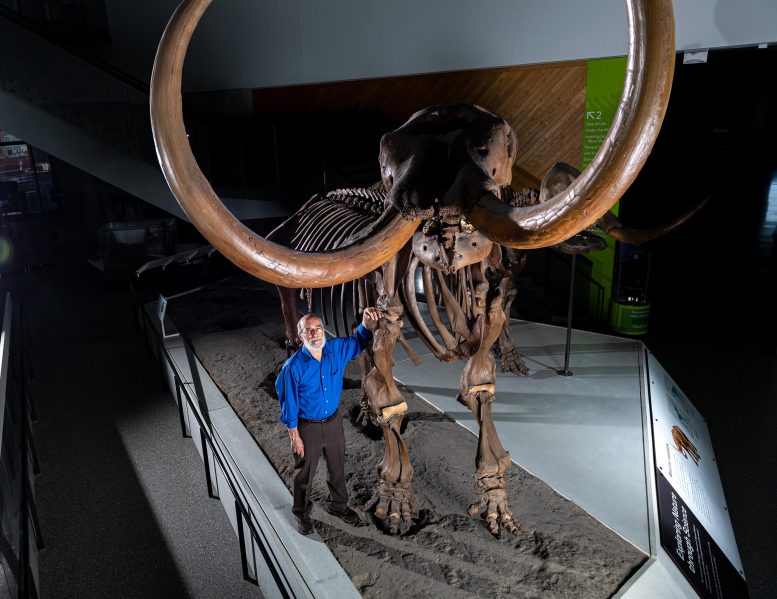
University of Michigan paleontologist Daniel Fisher with a mounted skeleton of the Buesching mastodon, based on casts of individual bones produced in fiberglass, on public display at the University of Michigan Museum of Natural History in Ann Arbor. Credit: Eric Bronson, Michigan Photography
Mastodons are relatives of elephants belonging to the genus Mammut that inhabited North and Central America before they went extinct about 10,000 to 11,000 years ago. Typical adults stood between 8 and 10 feet (2.5-3 m) tall at the shoulder and weighed around 8,000 to 12,000 pounds (3,600-5,400 kg). The largest specimen found was 10.7 feet (3.3 m) tall and weighed 24,000 pounds (11,000 kg). They lived in herds, mainly feeding on leaves and branches, a lot like modern elephants.
Although some evidence suggests climate change may have contributed to their extinction, it is generally believed that human hunting by Paleo-Indians was the main factor in their disappearance.
Around 13,200 years ago, a roving male mastodon died in a bloody mating-season battle with a rival in what today is northeast Indiana, nearly 100 miles (160 km) from his home territory, according to the first study to document the annual migration of an individual animal from an extinct species.
The 8-ton (7,200 kg) adult, known as the Buesching mastodon, was killed when an opponent punctured the right side of his skull with a tusk tip, a mortal wound that was revealed to researchers when the animal’s remains were recovered from a peat farm near Fort Wayne in 1998.
Northeast Indiana was likely a preferred summer mating ground for this solitary rambler, who made the trek annually during the last three years of his life, venturing north from his cold-season home, according to a paper published today (June 13, 2022) in Proceedings of the National Academy of Sciences.
The study also shows that the Buesching bull may have spent time exploring central and southern Michigan, which seems fitting for a creature whose full-size fiberglass-cast skeleton is on display at the University of Michigan Museum of Natural History in Ann Arbor.
“The result that is unique to this study is that for the first time, we’ve been able to document the annual overland migration of an individual from an extinct species,” said University of Cincinnati paleoecologist Joshua Miller, the study’s first author.
“Using new modeling techniques and a powerful geochemical toolkit, we’ve been able to show that large male mastodons like Buesching migrated every year to the mating grounds.”
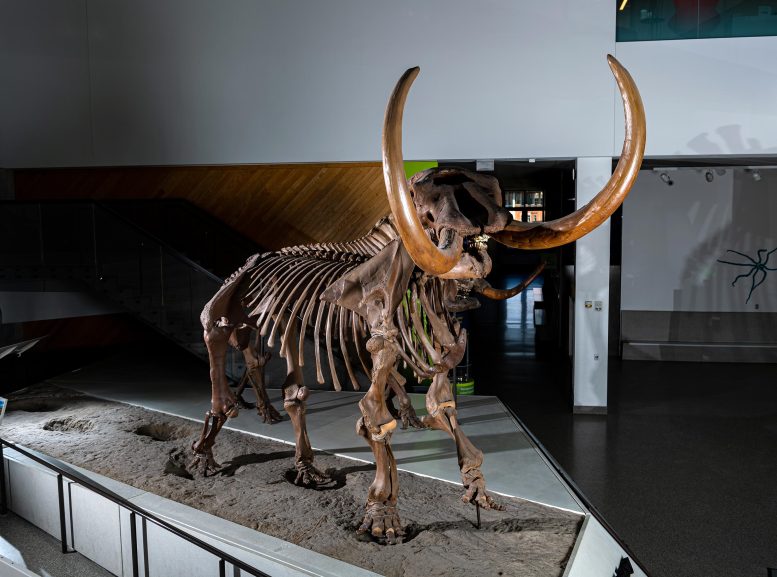
A mounted skeleton of the Buesching mastodon, based on casts of individual bones produced in fiberglass, on public display at the University of Michigan Museum of Natural History in Ann Arbor. The Buesching mastodon is a nearly complete skeleton of an adult male recovered in 1998 from a peat farm near Fort Wayne, Indiana. A new study, led by Joshua Miller of the University of Cincinnati and Daniel Fisher of the University of Michigan, uses oxygen and strontium isotopes from the mastodon’s right tusk to reconstruct changing patterns of landscape use during its lifetime. Credit: Eric Bronson, Michigan Photography
U-M paleontologist and study co-leader Daniel Fisher participated in the Buesching mastodon excavation 24 years ago. He later used a bandsaw to cut a thin, lengthwise slab from the center of the animal’s banana-shaped, 9.5-foot right tusk, which is longer and more completely preserved than the left.
That slab was used for the new isotopic and life-history analyses, which enabled scientists to reconstruct changing patterns of landscape use during two key periods: adolescence and the final years of adulthood. The Buesching mastodon died in a battle over access to mates at age 34, according to the researchers.
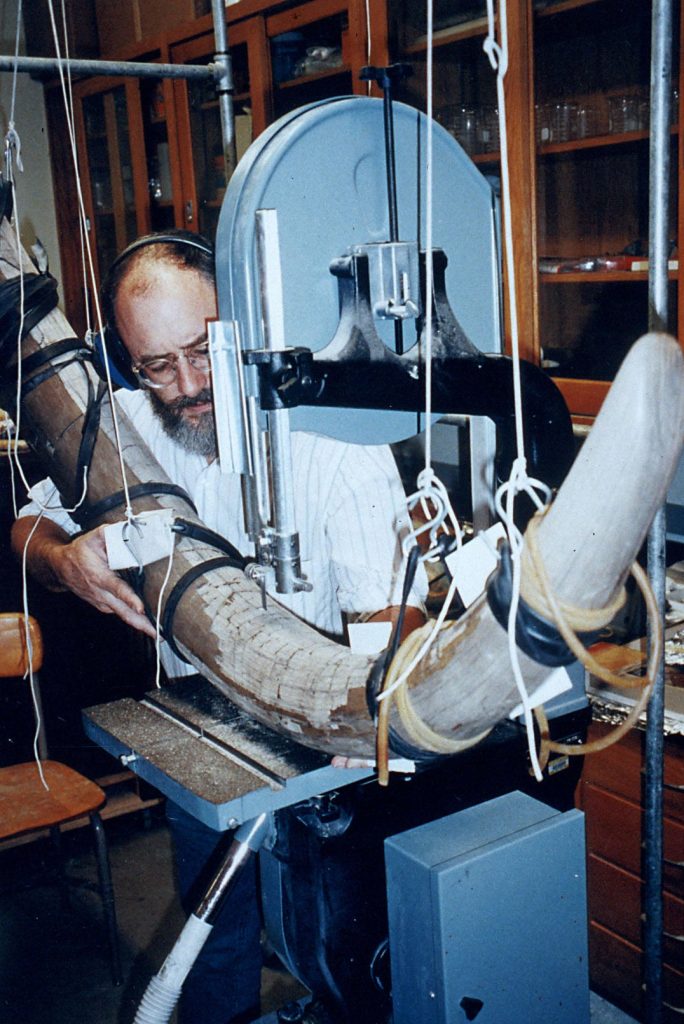
University of Michigan paleontologist and study co-leader Daniel Fisher participated in the Buesching mastodon excavation 24 years ago. He later used a bandsaw to cut a thin, lengthwise slab from the center of the animal’s banana-shaped, 9½-foot right tusk. That slab was used for the new isotopic and life-history analyses, which enabled scientists to reconstruct changing patterns of landscape use during two key periods: adolescence and the final years of adulthood. The Buesching mastodon died in a battle over access to mates at age 34, according to the researchers. Credit: Photo courtesy of Daniel Fisher
“You’ve got a whole life spread out before you in that tusk,” said Fisher, who has studied mastodons and mammoths for more than 40 years and helped excavate several dozen of the extinct elephant relatives.
“The growth and development of the animal, as well as its history of changing land use and changing behavior—all of that history is captured and recorded in the structure and composition of the tusk,” said Fisher, a professor of earth and environmental sciences, a professor of ecology and evolutionary biology, and a curator at the U-M Museum of Paleontology.
The team’s analyses revealed that the Buesching mastodon’s original home range was likely in central Indiana. Like modern-day elephants, the young male stayed close to home until he separated from the female-led herd as an adolescent.
As a lone adult, Buesching traveled farther and more frequently, often covering nearly 20 miles per month, according to the researchers. Also, his landscape use varied with the seasons, including a dramatic northward expansion into a summer-only region that included parts of northeastern Indiana—the presumed mating grounds.
“Every time you get to the warm season, the Buesching mastodon was going to the same place—bam, bam, bam—repeatedly. The clarity of that signal was unexpected and really exciting,” said Miller, who has used similar isotopic techniques to study the migration of caribou in Alaska and Canada.
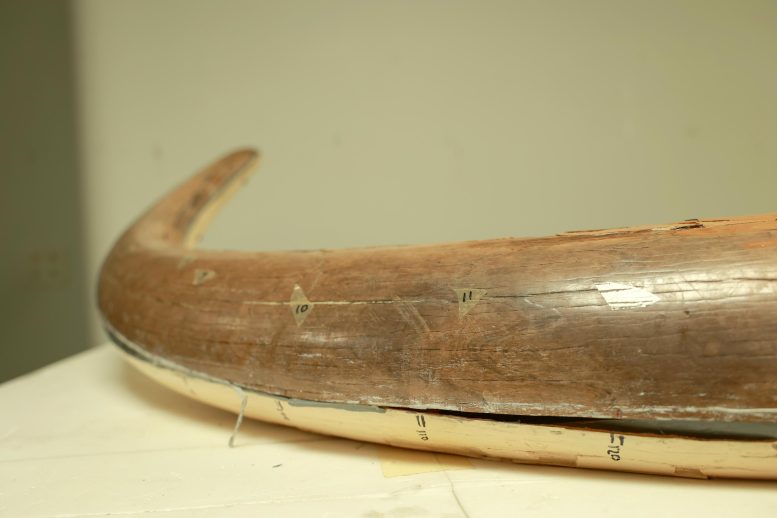
The left half of the Buesching mastodon’s right tusk. Numbers on the side of the tusk (9-11) indicate where specific annual layers (counting from the tip of the tusk to the end of life at the base) are exposed on the tusk surface. Credit: Jeremy Marble, University of Michigan News
Under harsh Pleistocene climates, migration and other forms of seasonally patterned landscape use were likely critical for the reproductive success of mastodons and other large mammals. However, little is known about how their geographic ranges and mobility fluctuated seasonally or changed with sexual maturity, according to the new study.
But techniques to analyze the ratios of various forms, or isotopes, of the elements strontium and oxygen in ancient tusks are helping scientists unlock some of those secrets.
Mastodons, mammoths and modern elephants, which are part of a group of large, flexible-trunked mammals called proboscideans, have elongated upper incisor teeth that emerge from their skulls as tusks. In each year of the animal’s life, new growth layers are deposited upon those already present, laid down in alternating light and dark bands.
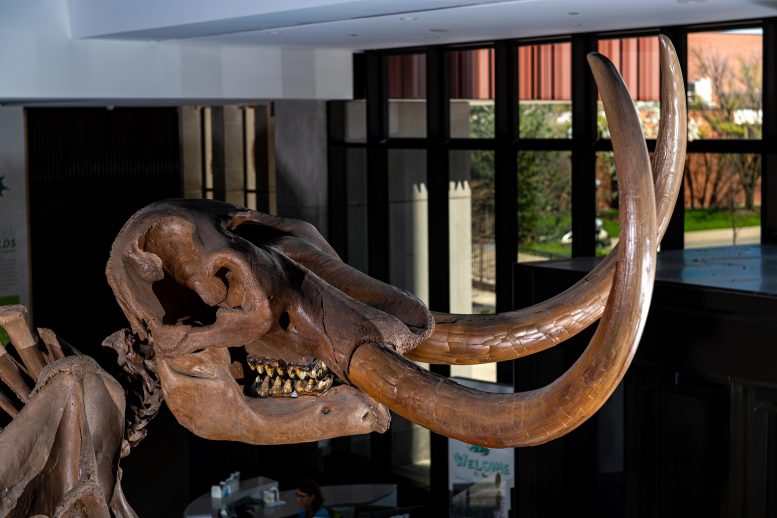
A mounted skeleton of the Buesching mastodon, based on casts of individual bones produced in fiberglass, on public display at the University of Michigan Museum of Natural History in Ann Arbor. The Buesching mastodon is a nearly complete skeleton of an adult male recovered in 1998 from a peat farm near Fort Wayne, Indiana. A new study, led by Joshua Miller of the University of Cincinnati and Daniel Fisher of the University of Michigan, uses oxygen and strontium isotopes from the mastodon’s right tusk to reconstruct changing patterns of landscape use during its lifetime. Credit: Eric Bronson, Michigan Photography
The yearly growth layers in a tusk are somewhat analogous to a tree’s annual rings, except that each new tusk layer forms near the center, while new growth in trees occurs in a layer of cells next to the bark. The growth layers in a tusk resemble an inverted stack of ice cream cones, with the time of death recorded at the base and the time of birth at the tip.
Mastodons were herbivores that browsed on trees and shrubs. As they grew, chemical elements in their food and drinking water were incorporated into their body tissues, including the gracefully tapered, ever-growing tusks.
In the newly published study, strontium and oxygen isotopes in tusk growth layers enabled the researchers to reconstruct Buesching’s travels as an adolescent and as a reproductively active adult. Thirty-six samples were collected from the adolescent years (during and after departure from the matriarchal herd), and 30 samples were collected from the animal’s final years of life.
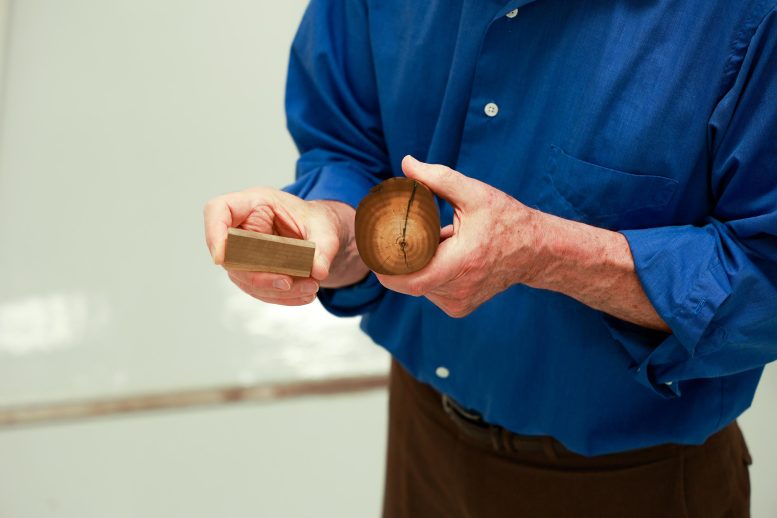
Closeup showing pieces of a mastodon tusk (not from the Buesching mastodon) held by University of Michigan paleontologist Daniel Fisher. In Fisher’s right hand is a block from near the base of the tusk, showing layers representing the last six years of life. A cross-section of a mastodon tusk tip, in Fisher’s left hand, shows concentric annual tusk layers. Credit: Jeremy Marble, University of Michigan News
A tiny drill bit, operated under a microscope, was used to grind half a millimeter from the edge of individual growth layers, each of which covered a period of one to two months in the animal’s life. The powder produced during this milling process was collected and chemically analyzed.
Ratios of strontium isotopes in the tusk provided geographic fingerprints that were matched to specific locations on maps showing how strontium changes across the landscape. Oxygen isotope values, which show pronounced seasonal fluctuations, helped the researchers determine the time of year a specific tusk layer formed.
Because both strontium and oxygen isotope samples were collected from the same narrow growth layers, the researchers were able to reach specific conclusions about where Buesching journeyed during different times of year, and how old he was when he made each trip.
Then, isotopic data from the tusks were entered into a spatially explicit movement model developed by Miller and his colleagues. The model enabled the team to estimate how far the animal was moving and the probabilities of movement between candidate locations—something absent from previous studies of extinct-animal movements.
“The field of strontium isotope geochemistry is a real up-and-coming tool for paleontology, archaeology, historical ecology, and even forensic biology. It’s flourishing,” Miller said. “But, really, we have just scratched the surface of what this information can tell us.”
Fisher and Miller said the next step in their mastodon research project is to analyze the tusks of a different individual, either another male or a female.
Reference: “Male mastodon landscape use changed with maturation (late Pleistocene, North America)” by Joshua H. Miller, Daniel C. Fisher, Brooke E. Crowley, Ross Secord and Bledar A. Konomi, 13 June 2022, Proceedings of the National Academy of Sciences.
DOI: 10.1073/pnas.2118329119
The other authors of the PNAS study are Brooke Crowley and Bledar Konomi of the University of Cincinnati, and Ross Secord of the Nebraska State Museum and the University of Nebraska-Lincoln.
The authors thank Kent and Janne Buesching for donating the Buesching mastodon for scientific study, and the Indiana State Museum for access to the specimen. Financial support was provided by the University of Michigan, University of Cincinnati Office of Research, Minihaha Foundation and National Science Foundation (EAR-9628063).

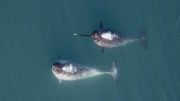
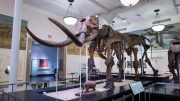
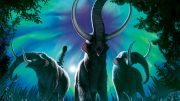
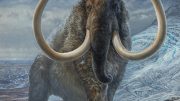
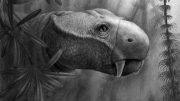
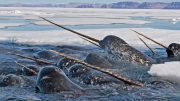

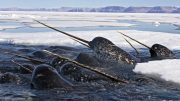
Quote “Although some evidence suggests climate change may have contributed to their extinction, it is generally believed that human hunting by Paleo-Indians was the main factor in their disappearance.”
That is simply not true and hasn’t been true for more than a decade. Here is what is TRUE, now. An asteroid/comet struck the Ice Cap. Melted it. Changed EVERYTHING. Almost everything in the western hemisphere over 100 pounds bodyweight died as a direct result. This includes the Clovis culture.
Stop repeating Clovis First nonsense.
Great article but shaky evidence. 1) Humans did not have the tools to kill mammoths. You cannot tell me that you can track a migration path that is exactly the same for this mammoth thru Northern Indiana based on the growth rings in theier tusks. You can find much of the same flora across different lattitude lines which proves no basis for this article.
Paleo Indians did have the tools (pits, spears, corraling, etc) to kill this size beast but it would take a lot of organizing, work and resources for a small and isolated band and the results would be dangerous and chancy. I don’t believe hunting pressure could have been significant.
Humans would much prefer a more modest size prey from rabbit to deer to bison. Only in desperation or for ritual would they (I believe) take on such a challenge. Modelling tends to show more of a problem with climate and vegetation changes. They might, on the other hand, scavenge meals from those killed by mating or natural hazards.